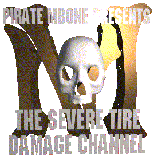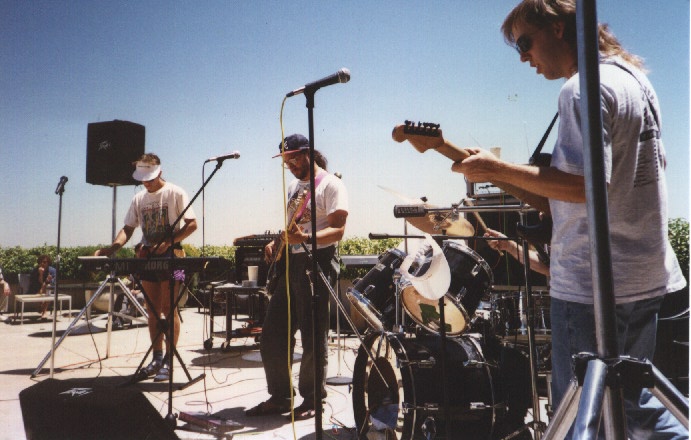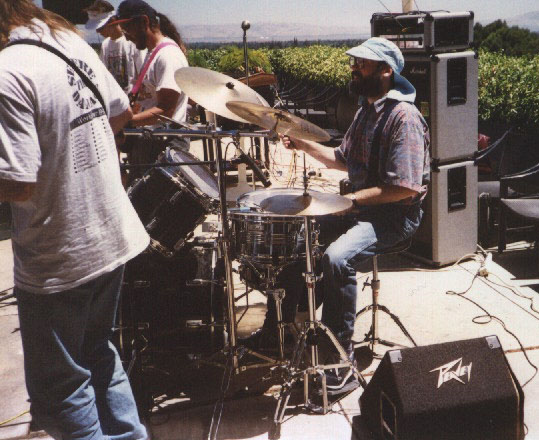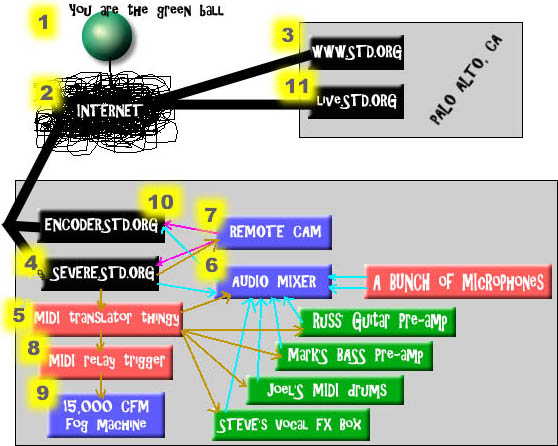How it Worked
These days, anyone can broadcast on the Internet.
Just pick up a phone or laptop and start singing.
But back then, it wasn't nearly as simple.
You (1) were wasting time on the Internet (2).
This is an accurate graphical map of the Internet.
You came to the Severe Tire Damage website (3).
A DEC Alpha running an Apache webserver, connected via OC16 to the Internet.
The Severe Tire Damage website informed you there was cool stuff to play with when the band was rehearsing.
When this was the case, you were able to get to "severe" (4).
"severe.std.org" was an SGI Indy.
When you clicked on any of the "controllable goodies" buttons, a command was issued at
"severe" to be sent to either the camera (7) or the
MIDI Translator Thingy (5).
The camera was a Canon VC-C1, a remotely controllable camera with a motorized pan and tilt head.
The camera may also have been a three-chip broadcast camera or a USB cheapie duct-taped to the guitar neck.
The camera fed not only the Severe Tire Damage Encoder (10) but also "severe" so you got immediate feedback.
"severe" received the camera's y/c input, the encoder usually got the NTSC composite.
The MIDI Translator Thingy (5) sent a command to the audio mixer (6).
The MIDI Translator Thingy was an Opcode "MIDI Translator II" designed for a Macintosh.
The audio mixer (6) had motorized faders to move appropriately, changing the volume or
other parameter of the sound, affecting the output sent to the Severe Tire Damage Encoder (10).
The audio mixer was a Yamaha DMP-7.
The green boxes were things that could be controlled by the MIDI Translator Thingy (5).
Everyone in the band had something MIDIable, potentially controllable via the web.
One of the things the MIDI translator thingy (5) could operate was the MIDI Relay Trigger (8).
The MIDI Relay Trigger was provided by MIDI Solutions Inc. of Vancouver, BC Canada
in return for this sentence.
The MIDI Relay Trigger (8) was usually attached to Severe Tire Damage's Industrial Strength Fog Machine (9).
The Fog Machine was a fifteen-thousand cubic foot per minute theatrical fog machine. It used non-toxic fog.
At least it said so right on the gallon jug of pina-colada scented fog juice.
While you were asphyxiating the band with Severe Tire Damage's Industrial Strength Fog Machine (9) you
watched the results via the Remote Cam (7) as encoded by Severe Tire Damage's Encoder (10).
The Encoder could be almost anything. Usually a laptop. Maybe even "severe".
The encoded audio and video stream was sent via the Internet (2) to live.std.org (11).
live.std.org was a massively well-connected machine in Palo Alto. Made by Compaq and running a RealServer.
Two different RealServers, actually.
The server at live.std.org (11) sent the buffered packetized multicast stuff into
the Internet (2) where it was eventually seen and heard by you (1).
Back then, your Internet connection was the limiting factor. Don't blame Severe Tire Damage.
You (1) were so impressed by all this you clicked the applause button, which was
actually an image map living at www.std.org (3), which sent a command via
the Internet (2) to severe.std.org (4) to play an audio file of people clapping into
the public address system, to which the band responded politely, all of which you
saw and heard eventually (6)(7)(10)(4)(2)(11)(2)(1).
It was an awful lot of technology just to see a garage band, don't you think?
Report of the Rolling Stones Performance
 In 1994, the Rolling Stones toured the world with their "Voodoo Lounge" album.
As part of the promotion for this tour, they decided to broadcast 20 minutes of their Dallas show onto the Internet MBone.
Thinking themselves novel, they proudly announced that they would be the first band to play live on the MBone.
However, they were quickly corrected by many people who explained that Severe Tire Damage had already done this long before.
As a result, the Stones promoted their MCast as the "first by a major band".
In 1994, the Rolling Stones toured the world with their "Voodoo Lounge" album.
As part of the promotion for this tour, they decided to broadcast 20 minutes of their Dallas show onto the Internet MBone.
Thinking themselves novel, they proudly announced that they would be the first band to play live on the MBone.
However, they were quickly corrected by many people who explained that Severe Tire Damage had already done this long before.
As a result, the Stones promoted their MCast as the "first by a major band".
To drive home the point that Severe Tire Damage was the first, the band "opened" for the Stones
by returning to the MBone on November 18, 1994, from 6:30-6:50pm PST.
Broadcasting from the Digital Systems Research Center in Palo Alto,
Severe Tire Damage played a short warmup set before the Stones,
which began on the same MBone channel at 7pm PST.
Severe Tire Damage also played some tunes after the Stones, at 8:05pm PST, on the same channel.
Audio engineering was by Ken Beckman,
MBone engineering was by Lance Berc,
both of Digital's Systems Research Center.
The press was generous, and Severe Tire Damage received many other comments about our 'cast.
If you were there, Severe Tire Damage wants to hear from you!
Comments Received During the 'cast November 18, 1994
Subject: not bad!
From: G.Huston@aarnet.edu.au (Australia)
To: band@world.std:com
Date: Fri, 18 Nov 1994 20:16:49 PST
that was cute - press on!
geoff
Subject: Please turn down the volume you're BREAKING UP!
From: Michael.Yee@Eng.Sun.COM (Michael Yee)
To: berc
Date: Fri, 18 Nov 1994 18:38:40 -0800
Subject: mbone
From: chang@cs.UMD.EDU
To: berc
cc: chang@cs.UMD.EDU
Date: Fri, 18 Nov 1994 21:39:07 -0500
Play some Carcass!
mike
Subject: Re: Stones Aftermath
From: Ross.Finlayson@Eng.Sun.COM (Ross Finlayson)
To: berc@src.dec.com
Date: Fri, 18 Nov 1994 22:21:06 +0800
> What did you think of the warm up act?
>
> Did it come through ok?
Yes, great. Putting Severe Tire Damage on as an opening (& closing) act was a neat idea.
--Ross.
ps. What did you do to get the logos, etc. to appear over the video?
Subject: Re: Stones Aftermath
From: Stephen Casner <CASNER@ISI.EDU>
To: berc@src.dec.com, van@ee.lbl.gov
Date: Fri 18 Nov 94 23:56:43 PST
> What did you think of the warm up act?
You mean the Stones?
-- Steve
From the Producers of the Rolling Stones 'cast
Subject: Re: Severe Tire Damage
From: sfitch@stones.com (Stephan Fitch)
To: rhaines@ix.netcom.com (Russell Haines)>
I dug you guys. I thought what you did just made the whole thing right.
Where did you find that quote? T'wasn't from me. Where were you guys anyway?
--sfitch
Subject: Re: Severe Tire Damage
From: Stephan Fitch <gmo@media.mit.edu>
To: rhaines@ix.netcom.com, sfitch@stones.com
Date: Sat, 26 Nov 94 14:22:02 -0500
Oh you mean our http: programmer. Naw - he dug you guys too.
When we did our server we decided to give it a voice of a
punk rocker. So he sounds punk...We're gonna do something
cool with your quote, "I sir, am not from Palo Alto -
maybe make it into a link and point to your homepage.
You guys made our Stones multicast magic. We've been
trying to make sure the press gives you guys the credit
which Ski Cry Babies have claimed. It's rock and
roll - and you guys made it a true concert.
stephan Fitch
Comments from Others in the Audience
Subject: Opening for the Stones
From: jbehrle@bbn.com
To: band@world.std
Cc: jbehrle@noc.bbn
Date: Sun, 20 Nov 1994 09:43:11 PST
Hey Guys,
Great job opening for the Stones on Friday! You were mentioned in today's Boston Sunday Globe,
let me know if you would like me to fax you a copy of the article.
-Jeremy Behrle
Subject: Today's NYT
From: lazowska@cs.washington.edu
To: weiser:PARC, karlin@cs.washington, raj@cs.washington, savage@cs.washington, elf@cs.washington,
dylan@cs.washington
Date: Tue, 22 Nov 1994 06:21:52 PST
"Tarnished"? What the hell do they mean by "tarnished"?
[see NYT article.]
Subject: Re: Stones MCast query....
From: smiller@bbn.com
To: Mark Weiser:PARC
Date: Fri, 2 Dec 1994 06:44:52 PST
Hey Severe Tire Damage!
We were at the BBN Network Operations Center in Cambridge ("ops@nic.near.net") with
the Boston Globe reporter. We saw your video come up and brought you up (we were
watching on a 5x8 foot screen with 8 speakers in the ceiling... Overkill, but fun).
Anyhow we caught you mid song and it was the guy from the globe who first recognized
the "Ass*&^e" song.
You guys were great, very entertaining (My favorite was the vat only rendition of
"Jungle Love" after the show.
If you send a Tshirt, It will hang in our Tshirt hall of fame here at the NOC
Take Care, hope to see you online again.
Steve Miller, BBN, 20/2d, 150 Cambridge Park Drive, Cambridge, MA 02138
Subject: Re: Stones MCast query....
From: slevy@geom.umn.edu
To: weiser:PARC
Date: Fri, 2 Dec 1994 09:16:55 PST
Hi. By chance Nov 18th was the night our MBone connection started working, and the
Stones was the only broadcast running, so we used it as a test. Tuned in in the middle,
so didn't hear your music. I'm not crazy about the Stones, so didn't listen long;
the audio quality would have been pretty poor even if I'd wanted to listen. This
definitely seems to be technology whose time isn't quite here yet.
I haven't seen anything in the local papers about this event.
What we actually wanted to use the MBone for is to "attend" a conference, Frontiers
of Mathematical Communication, from MSRI in Berkeley; it happens to be going on today
& tomorrow, under the session name "FMC".
--Stuart Levy, Geometry Center, University of Minnesota
Subject: Re: Stones MCast query....
From: ted.brunner@email.hub.tek.edu
To: Mark Weiser:PARC
Cc: tedb@icebox.labs.tek
Date: Fri, 2 Dec 1994 09:26:06 PST
Mark,
I wasn't in fact listening. I had set up vat/nv tools and vat_record/nv_record,
and went home for the evening. What I got on nv was nothing. (Our ip provider just
isn't very well connected.) The vat got just the stones segment, because I set up
the timers accurately...
But if you want to send me a tee-shirt I'd be happy to receive it :^)
Ted Brunner Tektronix Communication Systems Research Lab
ted.brunner@tek.com 14150 SW Karl Braun, Beaverton OR 97005
Subject: Stones on the net
From: rcs@cs.arizona.edu
To: Mark Weiser:PARC
Date: Fri, 2 Dec 1994 09:37:44 PST
My connection was crummy: The broadcast would be fine for maybe a minute, then go
catatonic for two, then come back. Frustrating, because I'd recognize a song, and
then have it disappear in the middle. I gave up on it after fifteen minutes or so.
(Also, we need better speakers on our workstations.)
Rich Schroeppel rcs@cs.arizona.edu
(University of Arizona, Tucson)
Subject: Re: Stones MCast query.... (fwd)
From: ryeatman@comp.uark.edu
To: weiser:PARC
Date: Fri, 2 Dec 1994 10:56:31 PST
Hi Mark,
Yes, I did get to enjoy your performance! Very interesting.
Your mcast came through MUCH better than the Stones.
Location: University of Arkansas, Fayetteville, AR
Subject: Re: Stones MCast Query
From: acmansker@ucdavis.edu
To: weiser@ubiq:com
Date: Fri, 2 Dec 1994 16:37:00 PST
Russ Hobby forwarded your email to me -- I was one of the viewers? participants?
-- kind of hard to categorize the experience. We had the whiteboard up, along with
sound and video. The video was interesting. There was occasional dropout, and
between that and the variation in frames-per-second, the effect was strongly reminiscent
of an early MTV music video, though artistically superior. We were able to hear
much of the audio portion -- caught Mick's greeting to the MBone participants --
but it was clear from activity on the whiteboard that some people were getting no
sound at all. Someone in southern California said it sounded fine to them, but
we were experiencing more audio dropout than video. Overall, it was a technically
interesting experiment. It might have been wiser for whoever set it up to can the
whiteboard -- every little bit of bandwidth helps, and I saw little of interest
on the pages I flipped through.
I don't know whether that qualifies as an interesting answer, but here's the address
where we were sharing? experiencing? the event.
Technology Resources
University of California
Davis, CA 95616
Ann Mansker
acmansker@ucdavis.edu
Subject: Re: Stones MCast query....
From: CASNER@isi.edu
To: weiser@ubiq:com
Date: Sat, 3 Dec 1994 00:59:09 PST
Hi Mark. I noticed that Lance was transmitting and may have seen a
minute or two while you were playing, but I have to confess that I
didn't pay close attention. I was trying to get things set up because
an API video crew was coming. However, I can claim to have seen most
of the first appearance of Severe Tire Damage on the MBone! [June 1993 -ed.]
-- Steve
Subject: Re: Stones MCast query....
From: lessem@ibg.colorado.edu
To: Mark Weiser:PARC
Date: Sat, 3 Dec 1994 01:04:06 PST
Sorry no press clippings, but several of us did sit around the
computer and watch you guys play. Your connection was much better than
the Stones broadcast and seemed to pretty well show off what the
potential of multicasting is.
One person did make the comment about the Stones show: You could
barely see them, and couldn't understand a word Mick Jagger
said---just like being there.
Subject: The November '94 Stones concert
From: kevinh@eit.com (Kevin Hughes)
To: band@world.std.com
Date: Wed, 1 Mar 1995 00:50:57 -0800
I was just webbing around when I noticed your list of VAT sites for the Stones broadcast.
Just for the record, I was rockin@eit.com (EIT in Menlo Park)
at the time, commandeering a co-worker's Indy. I found the pre-show
video incredibly dull, especially since MTV had been playing much the
same stuff all week hawking Stones products. So I was quite relieved
when you guys came on, it was great! I was the only one in the place
watching since my friends got tired of waiting for the show by scribbling
on the "Stones shared whiteboard" exchanging Beavis and Butthead quotes
with some guy from Finland.
Perhaps one of the funniest parts was when Van Jacobson told everyone to shut up.
Maybe you should ask for a link on the Internet Underground Music Site...or at least put up some music videos!
Long live the MBONE,
-- Kevin
Kevin Hughes * kevinh@eit.com
Enterprise Integration Technologies Webmaster (http://www.eit.com/)
Hypermedia Industrial Designer * Duty now for the future!



